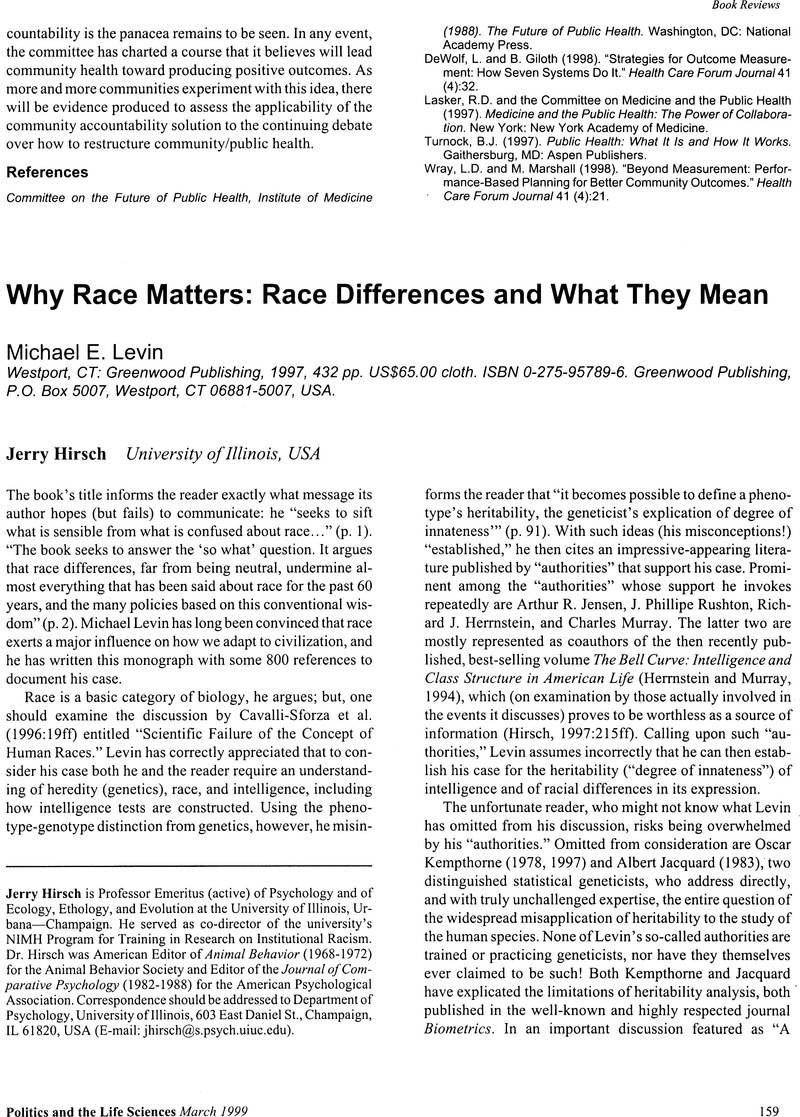No CrossRef data available.
Article contents
Why Race Matters: Race Differences and What They MeanMichael E. Levin Westport, CT:Greenwood Publishing, 1997, 432 pp. US$65.00 cloth. ISBN 0-275-95789-6. Greenwood Publishing, P.O. Box 5007, Westport, CT 06881-5007, USA
Published online by Cambridge University Press: 17 May 2016
Abstract
An abstract is not available for this content so a preview has been provided. Please use the Get access link above for information on how to access this content.

- Type
- Book Reviews
- Information
- Copyright
- Copyright © Association for Politics and the Life Sciences
References
Cavalli-Sforza, L.L., Menozzi, P., and Piazza, A. (1996). The History and Geography of Human Genes. Abridged paperback edition. Princeton NJ: Princeton University Press.CrossRefGoogle Scholar
Cohen, J. (1988). Statistical Power Analysis for the Behavioral Sciences. Second edition. Hillsdale, NJ: Lawrence Erlbaum. (First edition 1969, revised edition 1977).Google Scholar
Harrington, G. (1975). “Intelligence Test May Favour the Majority Groups in a Population.” Nature 258:708–9.Google Scholar
Harrington, G. (1984). “An Experimental Model of Bias in Mental Testing.” In Reynolds, C.R. and Brown, R.T., (eds.), Perspectives on Bias in Mental Testing. New York: Plenum.Google Scholar
Harrington, G. (1988). “Two Forms of Minority-Group Test Bias as Psychometric Artifacts with an Animal Model (Rattus norvegicus).” Journal of Comparative Psychology 102:400–407.CrossRefGoogle Scholar
Herrnstein, R.J. and Murray, C.A. (1994). The Bell Curve: Intelligence and Class Structure in American Life. New York: Free Press.Google Scholar
Hirsch, J. (1997). “Some History of Heredity-vs.-Environment, Genetic Inferiority at Harvard(?), and The (Incredible) Bell Curve.” Genetica 99:207–22.CrossRefGoogle Scholar
Kempthorne, O. (1978). “A Biometrics Invited Paper: Logical, Epistemological and Statistical Aspects of Nature-Nurture Data Interpretation.” Biometrics 34:1–23.Google Scholar
Kempthorne, O. (1997). “Heritability: Uses and Abuses” [Paper presented at the University of Illinois, April 22, 1993]. Genetica 99:109–11.CrossRefGoogle Scholar
McGuire, T.R. and Hirsch, J. (1977). “General Intelligence (g) and Heritability (H2, h2).” In Uzgiris, I.C. and Weizmann, F., (eds.), The Structuring of Experience. New York: Plenum.Google Scholar
Miller, A. (1994). “Academia's Dirty Secret: Professors of Hate.” Rolling Stone (October 20):106–11.Google Scholar
Reynolds, C.R. and Brown, R. T., eds. (1984). Perspectives on Bias in Mental Testing. New York: Plenum Press.CrossRefGoogle Scholar


